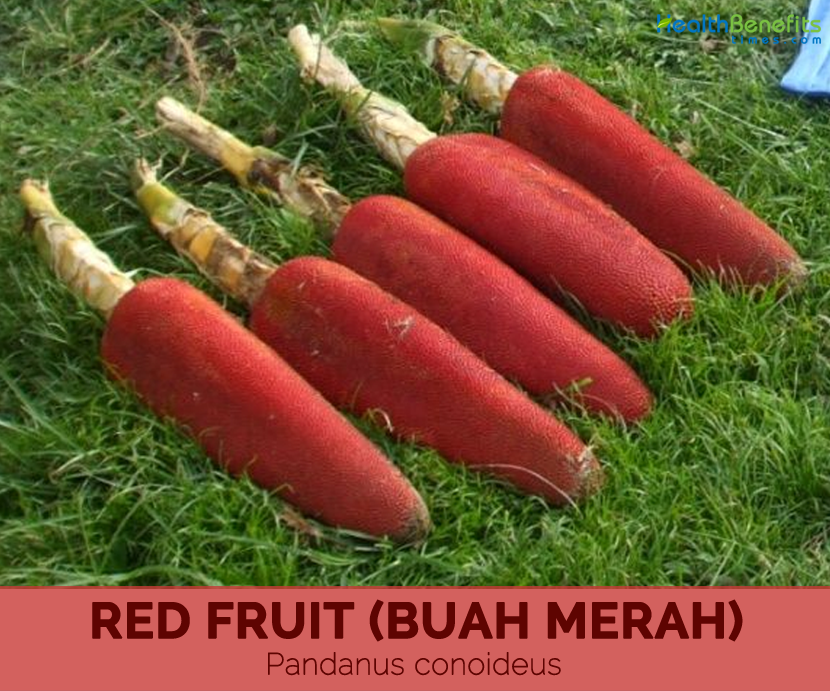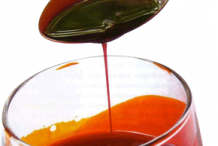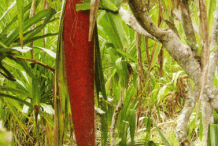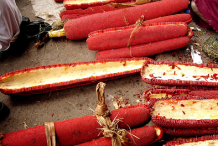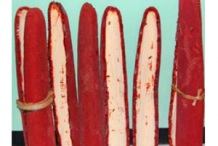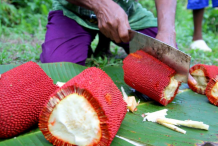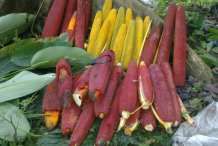| Red Fruit (Buah Merah) Quick Facts |
| Name: |
Red Fruit (Buah Merah) |
| Scientific Name: |
Pandanus conoideus |
| Origin |
Papua, Indonesia |
| Colors |
Green to bright orange, red, maroon and also to brown or yellow as it matures |
| Shapes |
Fruit head short and oblong to elongate and cylindrical, when ripe. 30-120 cm long and 10-25 cm diameter |
| Flesh colors |
Creamy White |
| Calories |
868 Kcal./cup |
| Major nutrients |
Total Fat (269.14%)
Vitamin E (141.33%)
Carbohydrate (3.92%)
Sodium (0.20%)
|
| Health benefits |
Help cure AIDS & Heal Cancer |
Pandanus Conoideus commonly known as Red Fruit, Kuansu, Buah Merah, Screwpine, Pandanus ‘Cokelat’, Marita, Oil Pandan and Red Pandanus is a plant that grows in the mountain regions of Papua, Indonesia especially in Jayawijaya mountain area (Wamena and Tolikara), Jayapura, Manokwari, Nabire, Timika, and Ayamaru Sorong. Pandanus conoideus is a plant in the pandan family. Buah Merah comes from the Indonesian term Buah (meaning Fruit) and Merah (meaning Red). It simply means Red Fruit and looks like a giant carrot. Buah Merah can only be found in the mountainous parts of Papua, Indonesia. It can grow in huge sizes around 100 cm in length, 18 cm in diameter length and weighs about 7.5 kg. The fruit has a blunt edge and cylindrical shape. These types of plants carry fruit in the age of 3 years from planting. It has known several medicinal applications which the natives use and was also believed to be a good supplement.
There are around 30 cultivars of Red Fruit. But only four variants have high economy values among others such as merah panjang (long red), merah pendek (short red), cokelat (brown), and kuning (yellow). Red Fruit variants that are used as medicine is of merah panjang (long red). It is traditionally believed to be a good supplement as a skin and eye medicine, and as worm treatment. The fruit is typically prepared by splitting it, wrapping it in leaves, and cooking it in an earth oven.
Description
Red Fruit (Buah Merah) is actually a branching, dioecious evergreen aborescent shrub, growing 15 meters high. It grows best in moist locations, often under shade, and tolerates water-logged soils. It thrives in loose, fertile soil rich in humus. Its roots constitute the root of the air which strung to the height of one meter through the bottom of the stem. Stem is brown with white spots, round, beam vessels does not seem obvious, hard, direction grow vertically or upright, branching number 2-4, and prickly surface.
Leaves
Leaves are sessile, densely arranged in corkscrew spirals towards the terminal of the stem and branches, broadly linear, strap-shaped, 1–2 m long by 5–8 cm wide, bright green, glaucous beneath, thin to firm, apex acute, margins and mid rib prickly.
Flower
Male inflorescence is unknown. Female inflorescence is oblong-cylindrical head enclosed by bracts, stigma flat and broad.
Fruit
Fruit head is short and oblong to elongate and cylindrical, when ripe. They are 30-120 cm long and 10-25 cm diameter. The fruit is green to bright orange color turning to red, maroon and also to brown or yellow as it matures. An average weight of the fruit is about 7.5 kg. External skin of the fruit looks like a jack fruit.
Health benefits of Red fruit
Red fruit is a nutrient dense fruit which consists of huge amount of nutrients, vitamins, minerals. We can find numerous health benefits of Red fruit (Buah Merah). Listed below are some of the benefits of the Red fruit (Buah Merah). Read them to know more
1. Help cure AIDS
Among any other medicines, supplements, Buah Merah have shown effectiveness in avoiding and treating AIDS. By taking the fruit extract three times a day, it helps the patient increase body weight, make the skin smoother again, and help to grow the hair again. In short, it can help the patient to be much healthier again. Buah Merah is rich in tocopherol and beta-carotene which strengthens the body’s immune system. Not just that, if these two antioxidants are combined these can kill the virus that causes HIV and AIDS.
2. Heal Cancer
Cancer is one of the popular life taking, much-hated disease in this world. Buah Merah help in localizing the cancer cells making sure that it will not spread unimaginably in the patient’s body. Apart from that it eliminates the cancer cells. With the red fruit, it avoids the growth of cancer cells and stopped the spreading on affected patients. Also, it consists of Omega-3 which can be used in the restoration of damaged cells and tissues especially to patients suffering from Breast Cancer.
3. Cure Hepatitis
Hepatitis is a condition in which liver function is essential because of the virus. Hepatitis B and C usually are not handled may develop into liver cancer (sorosis). Red juice consists of antiviral and also antioxidant that could prevent the development of cancer cells. Additionally, the red fruit enhances the regrowth of liver cells.
Buah Merah is rich in antioxidants which help in the growing of cells in the liver and restore it. This helps in enhancing the liver function and eliminating the virus that caused Hepatitis. Antioxidants prevent the liver from suffering from sorosis – liver cancer.
4. Helps in preventing Stroke
Stroke is one of the fatal ailments nowadays and is commonly caused by hypertension. Buah Merah helps in boosting the flow of blood in the body making sure that oxygen in the blood is constant. This helps in lowering the level of blood pressure and helps the heart to pump in a good manner thus making the bloodstream thinner and avoids freezing that may lead to stroke.
5. Prevent and stop Diabetes
Tocopherols present in red fruit help in reducing the high amounts of sugar levels in the blood because it offers a sufficient amount of insulin. Tocopherols of Buah Merah boost the toil of the pancreas in producing insulin at a constant level. With that, the level blood glucose becomes in its regular state. However, it is also recommended that the management of diabetes may include proper diet and regular exercise. Some patients usually take insulin injections; however, these injections are not that cheap in price. So with Buah Merah extracts, treating diabetes can never be that so much expensive.
6. Help avoid Osteoporosis
Buah Merah consists of good amount of calcium and other essential minerals that helps in bone building and avoid the risk of osteoporosis. This due to the fact the red fruit consists of an abundant amount of calcium in this ratio, for every 55mg of red fruit there is 100g of calcium. Thus include red fruit (Buah Merah) in your everyday diet to get sufficient amount of calcium and make your bones fit and strong.
7. Lowers Uric acid in your system
As mentioned previously Buah Merah consists of good amount of tocopherols which can help in providing regular amounts of uric acid in the body because it improves the work system in the liver. Patients suffering from kidney stones usually take the extract three times a day helping their liver and kidney to be restored healthier again.
8. Improves Brain Function
Content of omega 3 and omega 6 present in the red fruit can easily promote the brain functions and also improve cleverness. As a result, red fruit is ideal for usage by kids.
Buah Merah is enriched with omega-3 and omega-6 which both enhances the function of the brain. This helps in improving immediate and serious thinking. It also boosts the delivery of signals from other senses to the brain therefore improving the body’s response. That is why it is often recommended to kids and old people.
9. Eye Disorders
Red fruit (Buah Merah) consists of good amount of beta-carotene content which can easily resolve many different types of eye illnesses brought on by insufficient vitamin A. Beta-carotene is soaked up and also refined with the body into vitamin A. Include Buah Merah in your daily diet for your better eye health.
10. Cholesterol
High cholesterol levels within the blood vessels, particularly triglycerides and also HDL (High Density Lipoprotein), can result in calcification as well as thinning of blood vessels within the heart, brain and also kidney. The trigger may be the usage of foods that contains saturated fatty acid overload. Red juice can easily counteract cholesterol within the blood vessels. So consume Buah Merah every day to get benefited.
11. D. Lupus
Lupus is certainly an autoimmune illness in which the body’s defense mechanisms hyperactive and also attacks will become regular, healthy tissue. This particular results in signs and symptoms just like swelling, inflammation, and also injury to important joints, skin, kidneys, blood, the heart, and also Lungs. So consume Buah Merah every day to get rid of such type of illness.
Origin
Distribution of Red fruit is limited to New Guinea and some of the islands to the west (Ceram, Buru and Ternate) in Indonesia to West Pacific. It grows in all Papua regions, especially in Jayawijaya mountain area (Wamena, Tolikara Kelila, Bokondini, Karubaga, Kobakma, Kenyam and Pasema), Jayapura, Manokwari, Nabire, Timika, and Ayamaru Sorong. Within Papua New Guinea, Red fruit is found in all mainland provinces, particularly in the highlands and in the Momase Region, and sometimes on Manus and West New Britain. It is most common in the following provinces: Eastern Highlands, Morobe, Western Highlands, Southern Highlands, East Sepik, Simbu, Madang and Sandaun. The species is also reported in the wild in Maluku.
Traditional Medicinal benefits of Buah Merah
- Buah Merah Mix Juice is also good in curing dengue fever.
- Red fruits oil is used by people for traditional medicine.
- Red fruit is used by local people as natural medicine for many diseases such as cancer, arteriosclerosis, rheumatoid arthritis, and stroke.
- Red fruit has been known to local inhabitants in Papua for many generations as a natural food supplement containing medicinal qualities and as a dye.
- Red fruit oil has been used in ethnic tribal communities for stamina and illnesses.
- It is traditionally believed to be a good supplement as a skin and eye medicine, and as a vermifuge.
- The special usage of the oil is to cure some diseases, such as cancer, HIV, malaria, cholesterol and diabetes mellitus.
Culinary Uses
- Fruit is cut into pieces then boiled, roasted or cooked in a stone oven.
- Pulp and seeds are removed from the core, mashed with water and strained to produce a thick, rich red sauce.
- This pleasant-tasting, oily, vitamin-A-rich, ketchup like sauce is used to flavor other foods such as sage, sweet potato, banana, pumpkin and green vegetables.
- Oil extracted from the fruit is used as valuable food flavoring because it contains high nutrients, such as b -carotene, also utilized as natural colorant that does not contain heavy metals and pathogenic microorganisms.
- The fruit is also eaten by directly sucking off the edible mesocarp.
Other Facts
- Red fruit is the traditional fruit of Papuans, who served during the “burn stone” ceremony.
- Leaves are dried out and rolled, and used to make mats in Kerala, India; and Hawaii.
- It is said that this strain of Buah Merah is harvested twice a year.
- Roots can be made rope, binding and mats then the trunk as the board.
- Red fruit is one of the most important cultivated trees in orchards and around houses in highland Papua New Guinea.
- Dregs of red fruit oil extraction can be used as feed supplement for poultry.
- Oil from drupes is also used as hair and body oil, as polish for arrow shafts, and for paints and dyes.
- Leaves are sometimes used for thatching materials.
- Leaves stem bark, and roots from red fruit plant are used to make ropes, yarn, and seat cover, even as a bed for sleeping.
- The leaves stem bark and root of the red fruit are used in making handicrafts by the indigenous Papuans.
- Young leaves are used as a substitute for cigarette wrap.
Precautions
- Care has to be taken when handling the leaves because of their sharp spines.
References:
https://www.itis.gov/servlet/SingleRpt/SingleRpt?search_topic=TSN&search_value=896128#null
http://davesgarden.com/guides/pf/go/177818/
http://www.odessahealth.org/important-things-you-need-to-know-about-buah-mera-or-red-fruit/
http://ccrc.farmasi.ugm.ac.id/en/?page_id=349
http://www.phytopharmajournal.com/Vol5_Issue5_02.pdf
http://www.theplantlist.org/tpl1.1/record/kew-286576
Comments
comments


